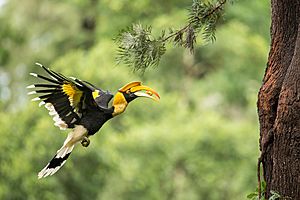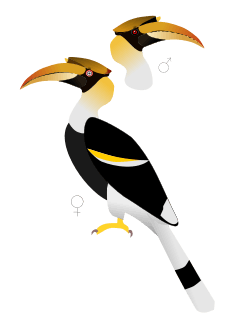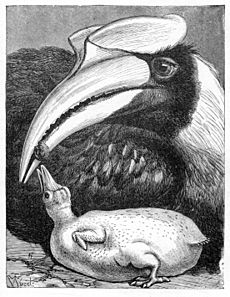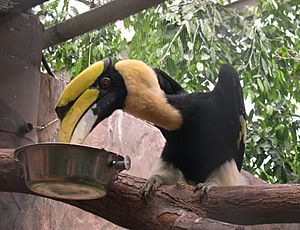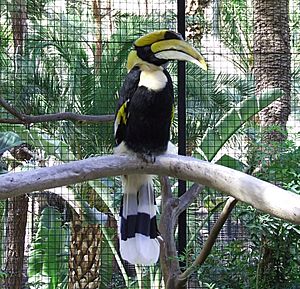Great hornbill facts for kids
Quick facts for kids Great hornbill |
|
|---|---|
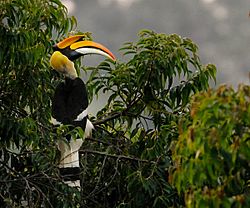 |
|
| Perched on a Mesua tree at Valparai, South India | |
| Conservation status | |
| Scientific classification | |
| Kingdom: | |
| Class: | |
| Order: | |
| Family: | |
| Subfamily: | |
| Genus: |
Buceros
|
| Binomial name | |
| Buceros bicornis Linnaeus, 1758
|
|
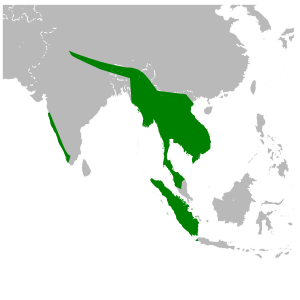 |
|
The great hornbill (Buceros bicornis) is also known as the great Indian hornbill or great pied hornbill. It is one of the largest birds in the hornbill family.
These impressive birds live in the forests of Nepal, India, the Malay Peninsula, and Sumatra, Indonesia. Their large size and bright colors make them important in many tribal cultures. Great hornbills can live for a long time, sometimes nearly 50 years when cared for by humans. They mostly eat fruit, but they can also hunt small mammals, reptiles, and other birds.
Contents
About the Great Hornbill
The great hornbill is a very large bird. It can be about 95 to 130 centimeters (37 to 51 inches) long. Its wings can spread up to 152 centimeters (60 inches) wide. It weighs between 2.15 and 4 kilograms (4.7 to 8.8 pounds). It is the heaviest hornbill in Asia.
Female hornbills are smaller than males. They also have bluish-white eyes, while males have red eyes. The skin around their eyes is pinkish. Like other hornbills, they have long, noticeable "eyelashes."
The Hornbill's Casque
The most striking part of the hornbill is the bright yellow and black casque on top of its huge bill. The casque looks like a U-shape from the front. The top is curved inward, with two ridges on the sides. These ridges form points at the front. This is why its scientific name, bicornis, means "two-horned."
The back of the casque is reddish in females. The underside of the front and back of the casque is black in males. The casque is hollow. Scientists are not sure what its main purpose is. Some think it helps attract mates. Male hornbills have been seen gently bumping their casques together while flying.
Males spread a yellow oil from a gland onto their feathers and bill. This gives them their bright yellow color. The edge of their beak is black and has a saw-like pattern. This edge can become smooth as the bird gets older.
Flight and Sounds
When great hornbills fly, their wing beats are very strong and loud. You can hear the sound from far away. Some people say it sounds like a steam train starting up. They fly with strong flaps, then glide with their wing feathers spread out and curved upwards. Sometimes, they fly very high above the forests.
Where Great Hornbills Live
Great hornbills live in the forests of India, Bhutan, Nepal, Mainland Southeast Asia, and the Indonesian island of Sumatra. They are found in different areas across India and Southeast Asia. In India, they live in some forest areas of the Western Ghats and along the Himalayas. Their home also reaches into Thailand, Burma, Malaysia, and Sumatra. A small group of these birds also lives in Singapore.
They prefer dense, old forests in hilly areas. They need large parts of the forest to live, unlike some smaller hornbills.
Great Hornbill Behavior
Food and Eating Habits
Great hornbills usually live in small groups. Sometimes, many birds gather together at fruit trees. A group of up to 200 birds has been seen in Bhutan. In the wild, great hornbills mostly eat fruit. Figs are a very important food for them. Another important food source is a tree called Vitex altissima. They also like fruits that are rich in fats.
Hornbills get all the water they need from the fruits they eat. They are very important for spreading the seeds of many forest trees. They also eat small mammals, birds, small reptiles, and insects. Sometimes, Lion-tailed macaques are seen eating alongside these hornbills.
They search for food along branches, hopping from one to another. They look for insects, baby birds, and small lizards. They might tear off bark or look under it. When they catch prey, they toss it in the air and swallow it whole.
Reproduction and Life Cycle
During the breeding season, which is from January to April, great hornbills become very noisy. The male makes a loud "kok" sound about once a second. Then the female joins in. They call together, making a mix of roars and barks.
They like to nest in old, mature forests. They prefer large, tall trees, especially those that stand above the other trees. Great hornbills form pairs that stay together. They live in small groups of 2 to 40 birds. Sometimes, up to 20 birds gather for courtship displays.
The female hornbill builds her nest inside a hollow in a large tree trunk. She seals the opening with a plaster made mostly of her own waste. She stays inside the nest, relying on the male to bring her food. She stays there until the chicks are about half-grown. During this time, the female loses all her old feathers and grows new ones. The male feeds her through a small slit in the sealed nest.
The female lays one or two eggs. She sits on them for about 38 to 40 days. Both the female and the chicks (after two weeks old) push their waste out through the nest slit. Once the female comes out of the nest, the chicks seal it again.
Young hornbills do not have a casque. After two years, the front part of the casque starts to separate from the beak. In the third year, it becomes a curved shape. It takes about five years for the casque to fully grow.
Sleeping Habits
Great hornbills use the same sleeping spots regularly. They arrive at sunset from far away, following the same paths each day. They choose the highest branches of tall trees that have few leaves. They move around to find the best spot until it gets dark. When they sleep, they pull their neck back and hold their bill pointing upwards.
Great Hornbills in Zoos
Not many great hornbills are kept in zoos, and even fewer have babies there. Female hornbills at nests are easy to catch, so most wild-caught birds are female. It has been very hard to get them to breed in zoos. This is because they are very picky about their mates and form strong, long-lasting pairs.
In zoos, hornbills eat fruits and meat. A healthy diet for them includes mostly fruit and some protein. Some hornbills have become friendly with people in zoos. However, their behavior in captivity is often described as nervous. Hornbills in zoos sometimes stretch out their wings to sunbathe.
Great Hornbills in Culture
Tribal peoples have hunted the great Indian hornbill for its different parts. Feathers are used for head-dresses, and skulls are often worn as decorations. In parts of northeastern India and Borneo, the feathers are very important. For example, among the Zomi people, a festival is not complete without a hornbill feather.
Conservation groups have tried to help. They provide tribes with feathers from hornbills in zoos. They also offer fake casques made of ceramic to use instead of real ones.
The great hornbill is called homrai in Nepal, which means "king of the forest." In Malayalam, it is called "Vezhaambal."
As a Symbol

The great hornbill is the state bird of Chin State in Myanmar. It is also the state bird of Kerala and Arunachal Pradesh in India.
The Great Hornbill is used as the logo for Kerala Evergreen FC. This is an Indian professional football club from Thiruvananthapuram, Kerala, India.
A great hornbill named William was the model for the logo of the Bombay Natural History Society (BNHS). Their building is also named after him.
Images for kids
See also
 In Spanish: Cálao bicorne para niños
In Spanish: Cálao bicorne para niños




